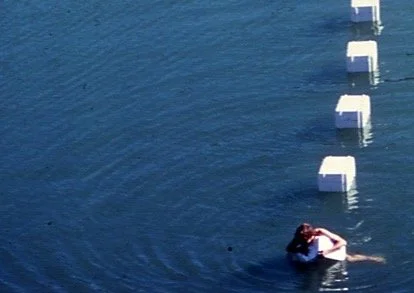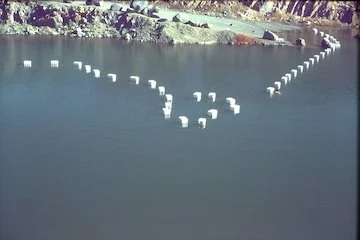Portrait of a Young Man
A Portrait of the Young Man
Early November 1975. I’ve just turned twenty-two. I’m nearly naked beside a body of deep, clear water near Chapel Hill, NC. My arms wrapped around my chest against the chill, my yellow boxers blow against my bony hips and skinny ass. All around me are large gray boulders set in a sloping grade covered with the crushed gravel of a rock quarry ––abandoned because it has filled with water. A man and a woman stand nearby with cameras, both dressed more sensibly. The woman is Ellen from my sculpture class. The guy is my friend Richard Kern, who will one day sell his photographs for high prices to soft-core magazines and then fashion glossies and then art collectors. But on this day no one has heard of him. He’s an art student, like me and Ellen. We have rejected the traditional ideas about art our professors are trying to put into our heads and have embraced the radical ideas we find in The Fox, a short-lived magazine of conceptual art created by Sarah Charlesworth and Joseph Kosuth, or Avalanche, Willoughby Sharp’s provocative art magazine. It’s late 1975 and the world is on fire. Pol Pot has seized Cambodia, helicopters have evacuated personnel from the roof of the U.S. Embassy in Saigon, Nixon’s accomplices have been convicted and two different women have tried to shoot President Ford.
We are convinced pleasing forms, be they sculpture or painting, are the playthings of the rich, something made only to be bought and sold, something to invest in, to bet on, like stock cars or race horses. That’s not what I signed up for. I signed up to become an artist in the same way other young folks signed up to join the Sierra Club or the Black Panthers. Let’s make this fucking world a better place. A few years earlier, watching the fiasco of the McGovern campaign, seeing politics and legislation were not going to improve the world, I decided real change would require a shift in public attitude. But how do you change a culture? I chose art, but I was pretty sure sellable paintings and sculptures were not going to shift anyone’s consciousness––they barely register on the seismograph of the culture before they disappear into some expensive home.
Robert Rauschenberg had pronounced he wanted to operate in the gap between art and life. For this pronouncement he got tons of critical praise, (and sold lots of artwork) but in 1975, he has not actually done it. My quest, at twenty-two, is to actually do it, but I don’t yet know how to go about it. I’d built sculptures from natural materials in the depths of the National Forest, locating them with Geodetic Survey markers; I’d shaved off the right side of my five-inch beard and walked around in public for a weekend as a way of mocking convention and conformity, but also as a way of asserting my self––my life–– as an artwork.
“You’ve come too far, too fast,” one of the sculpture professors says to me. “Suddenly, you’re out there somewhere with Vito Acconci and Chis Burden. Maybe you don’t know what you are doing.”
Yes, Acconci’s crazy performance pieces––masturbation under a false floor in Sonnabend gallery––and Burden’s provocations––having himself nailed crucifixion style to a VW bug––have gripped my imagination. I am in accord with their revulsion and their tactics. “Why do you think the job of the artist is to deal with form and space in a pleasing way?” I ask my professor.
He stares at me.
“Why shouldn’t art be about real life?” I insist. “Why shouldn’t we live our lives as if they were works of art?”
“Silly,” said some of my classmates. Good! I thought. If I can offend even wannabe artists, I’m getting somewhere! If I make my life into my art, I can’t be co-opted into the cancerous capitalist system. Of course, I hadn’t yet realized the market system might be an efficient way of moving ideas through the culture, nor had I given much thought to what might replace it or even what I meant by making my life my art. But I set myself on a path, trusting there might be a few blazes along the trail cut by other artists seeking a new way forward, but knowing eventually I would have to forge my own way; not knowing the destination; not knowing even the crossroads until I come upon them and am forced to choose one path or the other.
On the shore of the quarry are forty Styrofoam microscope boxes I’d scavenged from behind a science building on the UNC campus. My idea is to string these boxes together with something imperceptible so they are connected to each other but not visibly so and then to exploit the inherent property of Styrofoam, which is ninety-five percent air, and float them in a body of water, allowing the wind to blow them into different configurations. I believe this is an artwork about the immanence of the natural world.
Shivering a little, I stick my toe in the clear water and feel the gooseflesh prickle my thigh. I brace myself and wade into the water, the stones and the cold instantly making my feet ache. Holding the first white box to my chest, I frog kick across the bracing water as Ellen feeds the other boxes into the water one by one behind me. Richard is on the cliffs with his camera. I think the random action of the breeze will create patterns that will somehow be more authentic, more evocative, than the patterns I might make consciously. Richard begins documenting the event with color slides. The group of forty boxes trails behind me across the entire quarry, a slight breeze bending the line into an exquisite arc. I swim back to shore and pick up my own camera and hustle to take a series of black and white photos of the resulting combinations and compositions.
As a young artist, I abdicate control to the natural world. Yes, I expect the lightness of the Styrofoam and the soft breeze in the quarry will conspire to create beautiful or interesting compositions, but my real point is the beauty of the idea: in most of what we do, the natural world should call the shots. Forty-five years later, coming on the cache of slides documenting this day, I see something else. I see a critique of the art distribution system –– the accusation that it is nothing more than a tool of the wealthy, let’s see you try to sell this! which of course, is inextricably tied up with the critique of the ownership culture in general. Beyond this, I see the inkling of an idea there might be another paradigm, one where art is not owned. Surprisingly, I also see a concept that has been deeply important to my art practice for decades, the heartbreaking elegance of imperfection and transience, the patina of degradation. But it’s this young man whose insistence on actually living one’s life as a work of art that kills me.



